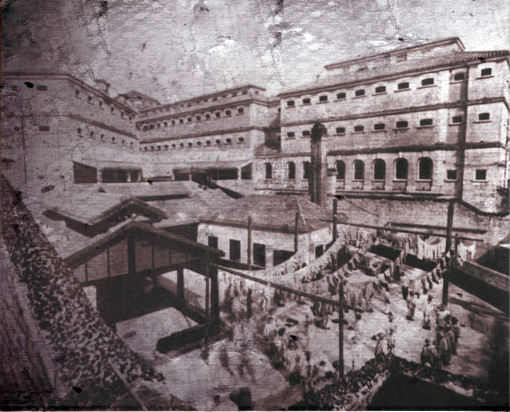Home>Victoria Prison > Do you know the early history of Victoria Prison?
Do you know the early history of Victoria Prison?
 Guo Gaoshou
Guo GaoshouIn the early years, Hong Kong became a hotbed for pirates, robbers, drug traffickers and smugglers, and also a haven for fugitives of the Qing court. Public order was unruly. After William Caine, Captain of the British Army, became the first Chief Magistrate on 30 April 1841, he built a grass shed to imprison arrested criminals at the corner of Bailey Street and Stanton Street. Later, as the crime rate soared, the prison cells became insufficient and Caine marked out a site on a slope on Old Bailey Street (now facing Victoria Prison), and used granite and bricks to build the first prison. It was completed on 9 August in the same year, and was named “Victoria Gaol”.
During the Taiping Rebellion, a large influx of refugees and Taiping rebels came to Hong Kong. The population boom drove up the crime rate, with the number of apprehended robbers and pirates increasing by the day. The prisons became fully occupied. To tackle the situation, the Government began prison expansion works on the east of Old Bailey Street (now Victoria Prison), which were completed in 1858.
With the number of inmates continuously rising, Victoria Gaol was soon insufficient for use and the authorities built another new prison on Stonecutters Island just off the coast in 1863. The construction work was done by the major criminals in Victoria Gaol. Meanwhile, a retired sea vessel named Royal Saxon was purchased and was berthed just off Stonecutters Island, which served to accommodate the inmates who participated in the construction work.
The prison vessel was highly overcrowded and diseases were rampant. The sampans transporting the prisoners were often overturned by the waves, drowning the prisoners. The Stonecutters Island Prison was completed in 1866, but it also failed to accommodate all prisoners. The prison vessel remained in use. In 1874, the vessel was overturned in a typhoon and the Stonecutters Island prison also suffered damages, causing many casualties among the inmates. By comparison, the inmates staying at the Victoria Gaol at Old Bailey Street were unscathed. This, according to locals, was one of the reasons why Old Bailey Street was called “the long slope” – those who lived in the Victoria Gaol enjoyed a longer life span. As the occurrence of prison break from the Stonecutters Island Prison were more frequent, it was later converted into a base for the Royal Navy.
In December 1876, Guo Gaoshou, the Qing Government Ambassador to the UK, together with the vice-ambassador Lau Shixiong and interpreter Zhang Deyi made a short stay in Hong Kong on their way to the UK, and visited the Victoria Gaol. They recorded their visit in the article ‘Shixi Jicheng’ (A Record of Official Visit to the West). In the article there was mention of “major criminals were jailed on the upper level. On the lower level each inmate is placed in once cell; on the upper level 3 inmates were placed in one cell. Each zone on each level had cells lining up in one row or two facing rows; iron grilles were installed in place.” This setting remains clearly visible in today’s Victoria Prison.
In 1879, the prison was no longer managed by the police force and the police force has no involvement in the prison business ever since. In 1899, the Prison Ordinance was amended and in the following year Victoria Gaol was renamed Victoria Prison, in memory of the Queen of Victoria of the UK.

Victoria Gaol
<
Back to Previous Page

Hong Kong Memory.All Rights Reserved©2014
 Guo Gaoshou
Guo Gaoshou